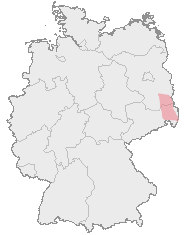Forum
- Home
- Forum

Sorbian flag

Sorbian region of Germany
Sorbs (Upper Sorbian: Serbja; Lower Sorbian: Serby; also known as Wends, Lusatian Sorbs or Lusatian Serbs) are a Western Slavic people of Central Europe living predominantly in Lusatia, a region on the territory of Germany and Poland. In Germany they live in the states of Brandenburg and Saxony. They speak the Sorbian languages (Wendish, Lusatian) - closely related[3] to Polish and Czech - officially recognized and protected as a minority language of Germany. They are predominantly Roman Catholics and Lutheran Protestants.
Sorbs are divided into two geographical groups:
Upper Sorbs, who speak Upper Sorbian (about 40,000 people).[4]
Lower Sorbs, who speak Lower Sorbian (about 20,000 people).[citation needed]
The dialects spoken vary in intelligibility in different areas.
Tribal division
Lusatian tribes are noted in the work of the Bavarian Geographer. The document contains a list of the tribes in Central-Eastern Europe east of the Elbe and north of the Danube to the Volga rivers to the Black and Caspian Sea most of them of Slavic origin.[5][6] Having settled by the Elbe, Spree and Neisse in the 6th century, Sorbian tribes divided into two main groups, which have taken their names from the characteristics of the area where they had settled. Sorbs living on the swampy broads of the Lower Spree have taken their name from the word marsh. The Milceni (ancestors of Upper Sorbs) settled on fertile soil around Upper Spree, the name derives from the word měl’ (loess soil). Both groups were separated from each other by a wide and uninhabited forest range. The rest of the tribes settled themselves between the Elbe and Saale. Among many Slavic tribes Bavarian Geographer noted also few lusatian tribes:
Glomacze - Dolomici
Milceni
Chutyz
Sitice
The relationship between the Sorbs and the Serbs
The mythical King of White Serbia (also known as Bojka, Boika, Boii), 6th century, was succeeded by two sons, one of them was the The Unknown Archont (Nepoznati Knez), the other according to the historical timeline, the ruler of the Serbs/Sorbs, Knez Dervan. Not more is known about him.
From the information we have today, it seems the region described as White 'unbaptized' Serbia or Boika in the Byzantine Chronicles,[7] lying east of the Franks (Germany), west of the White Croats (the inland regions of Silesia and Lesser Poland, according to Edward Gibbon),[8] north of the Turks (Magyars of Hungary), corresponds with the modern regions of north Bohemia, Lusatia and south-western Poland.
Facts that support this theory are the sharing of the linguistical grammar structure between the West Slav (Czech, Slovak, Polish) and the South Slav (Serb and Croat) language, that differs from the grammar structure of the Bulgarian language that also belongs to the South Slavic group, and the toponyms found in the region, north Bohemia (Srbsko, Srbská Kamenice etc., as well as the toponyms containing the ethnonym Chorvat, in the adjacent regions). Lusatian Slavic population still bearing the name Serbs in their native language. The region of Bohemia was known as the region of the Boii to the Romans, as well as the Byzantines, after the Celtic Boii tribe settling the region before Slavs. Byzantines often described people by the region (Tribalians, Thracians, Illyrians) they inhabited, even though the eponymous tribes were long extinct, rather than by the native names of the tribes they were carrying. The region called Boiheim by the western Rome (German suffix -heim) and Boika by the eastern Rome (Slavic suffix -ka) relates to the current region of Bohemia and corresponds to the ancestral region of White Serbia (stated as Boika in the De Administrando Imperio, chapter 32).
According to the historical and archeological data present at time, Serbs and Sorbs (South and North Serbs), were around 1400 years ago the same Polabian Slavic tribe. At the beginning of the 7th century it came to a split in between the tribe, the northern Serbs that stayed (now known as Lusatian Sorbs or Wends) were largely assimilated by the greater Slavic tribes (Poles, Czechs) as well as non-Slavic nations (Germans), immensely influencing their language and culture. The southern Serbs, on the other hand, conquered and assimilated lesser Slavic tribes, as well as the romanised Illyrian and Thracian population[9] of the Roman empire in Southeastern Europe, into their own Slavic tribe, thus laying the foundation for the medieval Serbian state.
more at
[ame] http://en.wikipedia.org/wiki/Sorbs [/ame]
Christianity and Feminism, the two deadliest poisons jews gave to the White Race
''Screw your optics, I'm going in'', American hero Robert Gregory Bowers